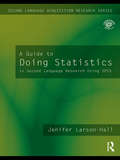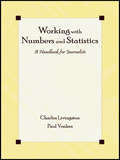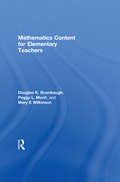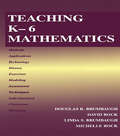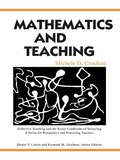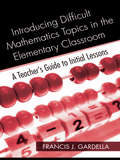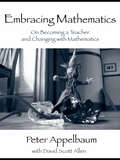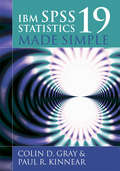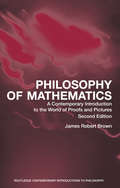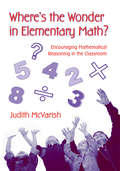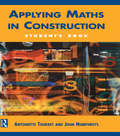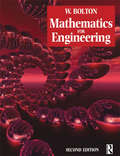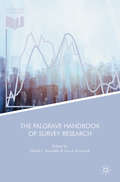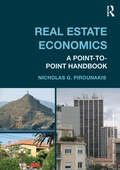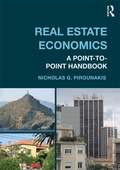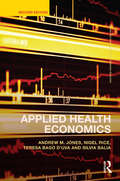- Table View
- List View
A Guide to Doing Statistics in Second Language Research Using SPSS
by Jenifer Larson-HallThis valuable book shows second language researchers how to use the statistical program SPSS to conduct statistical tests frequently done in SLA research. Using data sets from real SLA studies, A Guide to Doing Statistics in Second Language Research Using SPSS shows newcomers to both statistics and SPSS how to generate descriptive statistics, how to choose a statistical test, and how to conduct and interpret a variety of basic statistical tests. It covers the statistical tests that are most commonly used in second language research, including chi-square, t-tests, correlation, multiple regression, ANOVA and non-parametric analogs to these tests. The text is abundantly illustrated with graphs and tables depicting actual data sets, and exercises throughout the book help readers understand concepts (such as the difference between independent and dependent variables) and work out statistical analyses. Answers to all exercises are provided on the book’s companion website, along with sample data sets and other supplementary material.
Working With Numbers and Statistics: A Handbook for Journalists
by Charles Livingston Paul S. VoakesWorking With Numbers and Statistics: A Handbook for Journalists will bolster math skills and improve math confidence for journalists at all skill levels. Authors Charles Livingston and Paul Voakes developed this resource book to improve journalistic writing and reporting, enabling journalists to:*make accurate, reliable computations, which in turn enables one to make relevant comparisons, put facts into perspective, and lend important context to stories;*recognize inaccurate presentations, whether willfully spun or just carelessly relayed;*ask appropriate questions about numerical matters;*translate complicated numbers for viewers and readers in ways they can readily understand;*understand computer-assisted reporting; and*write livelier, more precise pieces through the use of numbers.The math is presented in a journalistic context throughout, enabling readers to see how the procedures will come into play in their work.Working With Numbers and Statistics is designed as a reference work for journalism students developing their writing and reporting skills. It will also serve professionals as a useful tool to improve their understanding and use of numbers in news stories.
Working With Numbers and Statistics: A Handbook for Journalists
by Charles Livingston Paul S. VoakesWorking With Numbers and Statistics: A Handbook for Journalists will bolster math skills and improve math confidence for journalists at all skill levels. Authors Charles Livingston and Paul Voakes developed this resource book to improve journalistic writing and reporting, enabling journalists to:*make accurate, reliable computations, which in turn enables one to make relevant comparisons, put facts into perspective, and lend important context to stories;*recognize inaccurate presentations, whether willfully spun or just carelessly relayed;*ask appropriate questions about numerical matters;*translate complicated numbers for viewers and readers in ways they can readily understand;*understand computer-assisted reporting; and*write livelier, more precise pieces through the use of numbers.The math is presented in a journalistic context throughout, enabling readers to see how the procedures will come into play in their work.Working With Numbers and Statistics is designed as a reference work for journalism students developing their writing and reporting skills. It will also serve professionals as a useful tool to improve their understanding and use of numbers in news stories.
Mathematics Content for Elementary Teachers
by Douglas K. Brumbaugh Peggy L. Moch MaryE WilkinsonTHE book for elementary education mathematics content courses! Designed to help prospective teachers of elementary school mathematics learn content beyond the rote level, this text stimulates readers to think beyond just getting the problem right and fosters their development into thoughtful, reflective, self-motivated, life-long learners. It stresses the what and why of elementary school mathematics content. Hints are provided about how to teach the content but this is mostly left to courses and texts that are dedicated to that purpose.The text is organized around the National Council for Teachers of Mathematics' Principles and Standards for School Mathematics. The Standards dictate the basic sections of the text. Within each section, appropriate specific topics are developed, intertwined with technology, problem solving, assessment, equity issues, planning, teaching skills, use of manipulatives, sequencing, and much more. In addition, major focal points of the Standards are emphasized throughout: effective teachers of mathematics should be able to motivate all students to learn, should understand the developmental levels of how children learn, should concentrate on what children need to become active participants in the learning environment, and should be engaged in ongoing investigations of new mathematical concepts and teaching strategies.Mathematics Content for Elementary Teachers is based on several fundamental premises:*The focus of mathematics education should be on the process, not the answer.*Elementary teachers should know the mathematics content they are teaching, know more than the content they are teaching, and teach from the overflow of knowledge.*It is important for teachers to be flexible in allowing students to use different procedures--teaching from the "overflow of knowledge" implies knowing how to do a given operation more than one way and being willing to examine many different ways.*Teachers need to learn to carefully cover the topics to be taught, to reflect upon them, and to be able to organize them. To help prospective elementary teachers concentrate on the mathematics content they will be expected to teach and begin to build the foundation for the methods they will use, this text includes only elementary mathematics content and does not address middle school concepts.Pedagogical features:*The text is organized according to NCTM Standards.*An informal writing style speaks directly to readers and is geared to pre-service teachers.*Focus is given to multiple methods of problem solving at four developmental levels.*Questions, exercises, and activities are interspersed throughout each section rather than gathered at the end of each chapter.*Complete solutions for exercises are provided.
Mathematics Content for Elementary Teachers
by Douglas K. Brumbaugh Peggy L. Moch MaryE WilkinsonTHE book for elementary education mathematics content courses! Designed to help prospective teachers of elementary school mathematics learn content beyond the rote level, this text stimulates readers to think beyond just getting the problem right and fosters their development into thoughtful, reflective, self-motivated, life-long learners. It stresses the what and why of elementary school mathematics content. Hints are provided about how to teach the content but this is mostly left to courses and texts that are dedicated to that purpose.The text is organized around the National Council for Teachers of Mathematics' Principles and Standards for School Mathematics. The Standards dictate the basic sections of the text. Within each section, appropriate specific topics are developed, intertwined with technology, problem solving, assessment, equity issues, planning, teaching skills, use of manipulatives, sequencing, and much more. In addition, major focal points of the Standards are emphasized throughout: effective teachers of mathematics should be able to motivate all students to learn, should understand the developmental levels of how children learn, should concentrate on what children need to become active participants in the learning environment, and should be engaged in ongoing investigations of new mathematical concepts and teaching strategies.Mathematics Content for Elementary Teachers is based on several fundamental premises:*The focus of mathematics education should be on the process, not the answer.*Elementary teachers should know the mathematics content they are teaching, know more than the content they are teaching, and teach from the overflow of knowledge.*It is important for teachers to be flexible in allowing students to use different procedures--teaching from the "overflow of knowledge" implies knowing how to do a given operation more than one way and being willing to examine many different ways.*Teachers need to learn to carefully cover the topics to be taught, to reflect upon them, and to be able to organize them. To help prospective elementary teachers concentrate on the mathematics content they will be expected to teach and begin to build the foundation for the methods they will use, this text includes only elementary mathematics content and does not address middle school concepts.Pedagogical features:*The text is organized according to NCTM Standards.*An informal writing style speaks directly to readers and is geared to pre-service teachers.*Focus is given to multiple methods of problem solving at four developmental levels.*Questions, exercises, and activities are interspersed throughout each section rather than gathered at the end of each chapter.*Complete solutions for exercises are provided.
Teaching K-6 Mathematics
by Douglas K. Brumbaugh David Rock Linda S. Brumbaugh Michelle Lynn RockThis developmentally sound, research-based, practical text speaks directly to preservice elementary mathematics students about the multitude of ways they can help their future students learn to see the power, beauty, necessity, and usefulness of mathematics in the world.Part 1 deals with guiding principles that permeate the text, while Parts 2-11 deal with the specific NCTM Standards for grades K-6. Teaching K-6 Mathematics: *is aligned with the current NCTM Curriculum and Evaluation Standards for School Mathematics; *integrates content and methodology; *emphasizes use of technology as a teaching/learning tool; *stresses problem solving; *provides basic information on current research in mathematics education; *focuses on identification of error patterns and analysis; *uses a down-to-earth, friendly writing style that engages the student rather than prescribing what to do; and *includes many activities and exercises, including games, tricks, and amusements that can be used in the classroom to increase student interest in mathematics. Features: *Technology is integral throughout the text. Students are expected to perform Internet searches, investigate new sites appropriate for elementary students, sample new software that could be used in the classroom, and develop ways to blend calculators into the curriculum. *Manipulatives are considered essential for students to learn elementary mathematics concepts. Cuisenaire rods, base 10- blocks, chips, number lines, and geoboards are all part of the manipulative landscape that is created in this text. *Careful attention is given to blending rote work, developmental activities, fun, application, technology, manipulatives, assessment, and planning, so that prospective teachers become accustomed to using varied approaches and decision making as a curriculum is determined. *Tricks, Activities, and Games (TAG) provide a wealth of ideas to attract students to learning mathematics.
Teaching K-6 Mathematics
by Douglas K. Brumbaugh David Rock Linda S. Brumbaugh Michelle Lynn RockThis developmentally sound, research-based, practical text speaks directly to preservice elementary mathematics students about the multitude of ways they can help their future students learn to see the power, beauty, necessity, and usefulness of mathematics in the world.Part 1 deals with guiding principles that permeate the text, while Parts 2-11 deal with the specific NCTM Standards for grades K-6. Teaching K-6 Mathematics: *is aligned with the current NCTM Curriculum and Evaluation Standards for School Mathematics; *integrates content and methodology; *emphasizes use of technology as a teaching/learning tool; *stresses problem solving; *provides basic information on current research in mathematics education; *focuses on identification of error patterns and analysis; *uses a down-to-earth, friendly writing style that engages the student rather than prescribing what to do; and *includes many activities and exercises, including games, tricks, and amusements that can be used in the classroom to increase student interest in mathematics. Features: *Technology is integral throughout the text. Students are expected to perform Internet searches, investigate new sites appropriate for elementary students, sample new software that could be used in the classroom, and develop ways to blend calculators into the curriculum. *Manipulatives are considered essential for students to learn elementary mathematics concepts. Cuisenaire rods, base 10- blocks, chips, number lines, and geoboards are all part of the manipulative landscape that is created in this text. *Careful attention is given to blending rote work, developmental activities, fun, application, technology, manipulatives, assessment, and planning, so that prospective teachers become accustomed to using varied approaches and decision making as a curriculum is determined. *Tricks, Activities, and Games (TAG) provide a wealth of ideas to attract students to learning mathematics.
Mathematics and Teaching
by Michele D. CrockettMathematics and Teaching uses case studies to explore complex and pervasive issues that arise in teaching. In this volume, school mathematics is the context in which to consider race, equity, political contexts and the broader social and cultural circumstances in which schooling occurs. This book does not provide immediate or definitive resolutions. Rather, its goal is to provoke and facilitate thoughtful discussion about critical issues for professional decision-making in mathematics teaching. This is the 7th volume in Reflective Teaching and the Social Conditions of Schooling: A Series for Prospective and Practicing Teachers, edited by Daniel P. Liston and Kenneth M. Zeichner. It follows the same format as previous volumes in the series. Part I includes four case studies of classroom experiences: "Race and Teacher Expectations"; "Mathematics for All?"; "Culture and School Mathematics"; and "Politics and School Mathematics." Each case is followed by a space for readers’ own reactions and reflections, school stakeholders’ reactions, and a summary with additional questions for further discussion. Part II presents three public arguments representing different views about the issues that arise in mathematics teaching: conservative, liberal and radical multiculturalist. Part III offers the authors’ reflections on the centrality of culture in teaching mathematics, resources and exercises for further reflection, and a bibliography for further reading. Mathematics and Teaching is pertinent for all prospective and practicing teachers at any stage in their teaching careers. It is appropriate for any undergraduate and graduate course addressing mathematics teaching issues.
Mathematics and Teaching
by Michele D. CrockettMathematics and Teaching uses case studies to explore complex and pervasive issues that arise in teaching. In this volume, school mathematics is the context in which to consider race, equity, political contexts and the broader social and cultural circumstances in which schooling occurs. This book does not provide immediate or definitive resolutions. Rather, its goal is to provoke and facilitate thoughtful discussion about critical issues for professional decision-making in mathematics teaching. This is the 7th volume in Reflective Teaching and the Social Conditions of Schooling: A Series for Prospective and Practicing Teachers, edited by Daniel P. Liston and Kenneth M. Zeichner. It follows the same format as previous volumes in the series. Part I includes four case studies of classroom experiences: "Race and Teacher Expectations"; "Mathematics for All?"; "Culture and School Mathematics"; and "Politics and School Mathematics." Each case is followed by a space for readers’ own reactions and reflections, school stakeholders’ reactions, and a summary with additional questions for further discussion. Part II presents three public arguments representing different views about the issues that arise in mathematics teaching: conservative, liberal and radical multiculturalist. Part III offers the authors’ reflections on the centrality of culture in teaching mathematics, resources and exercises for further reflection, and a bibliography for further reading. Mathematics and Teaching is pertinent for all prospective and practicing teachers at any stage in their teaching careers. It is appropriate for any undergraduate and graduate course addressing mathematics teaching issues.
Introducing Difficult Mathematics Topics in the Elementary Classroom: A Teacher’s Guide to Initial Lessons
by Francis J. GardellaThis exciting text for the pre-service elementary teacher provides hands on mathematics lessons they can use to introduce mathematical concepts and skills that students find particularly challenging. Each chapter is divided into four sections: The Activity employs an engaging thought experiment to help the reader "visit a classroom" to understand how the lesson used to introduce the concept or skill would materialize in the class. The Mathematics provides the necessary mathematical background used in the lesson to make the actual teaching/learning situation comfortable for both the teachers and the learner. The Plan provides the reader with an actual lesson plan to engage the Activity in the classroom setting. Putting It All Together pulls the previous sections together with a summary of the chapter as well as further information for making the lesson successful. By providing models of what excellent lessons on a given topic look like, knowledge of the mathematics involved, and a concrete lesson plan structure this much-needed resource is the definitive mathematics planning vehicle that every teacher will want before they set foot in their own elementary classroom.
Embracing Mathematics: On Becoming a Teacher and Changing with Mathematics
by Peter Appelbaum With David AllenThis alternative textbook for courses on teaching mathematics asks teachers and prospective teachers to reflect on their relationships with mathematics and how these relationships influence their teaching and the experiences of their students. Applicable to all levels of schooling, the book covers basic topics such as planning and assessment, classroom management, and organization of classroom experiences; it also introduces some novel approaches to teaching mathematics, such as psychoanalytic perspectives and post-modern conceptions of curriculum. Traditional methods-of-teaching issues are recast in a new discourse, provoking new ideas for making mathematics education meaningful to teachers as well as their students. Co-authored by a professor and coordinator of mathematics education programs, with illustrative contributions from practicing elementary, middle, and high school mathematics teachers, this book is a unique collaboration across all pre-college grades, making it ideal for teacher discussion groups at any level. Embracing Mathematics: integrates pedagogy and content exploration in ways that are unique in mathematics education features textboxes with reflection questions and suggested explorations that can be easily utilized as homework for a course or as discussion opportunities for teacher reading groups offers examples of teachers’ action research projects that grew out of their interactions with the main chapters in the book is not narrowly limited to mathematics education but incorporates curriculum studies – an invaluable asset that allows instructors to find more ways to engage students in self-reflexive acts of teaching Embracing Mathematics is intended as a method text for undergraduate and master’s-level mathematics education courses and more specialized graduate courses on mathematics education, and as a resource for teacher discussion groups.
IBM SPSS Statistics 19 Made Simple
by Colin D. Gray Paul R. KinnearThis new edition of one of the most widely read textbooks in its field introduces the reader to data analysis with the most powerful and versatile statistical package on the market: IBM SPSS Statistics 19. Each new release of SPSS Statistics features new options and other improvements. There remains a core of fundamental operating principles and techniques which have continued to apply to all releases issued in recent years and have been proved to be worth communicating in a small volume. This practical and informal book combines simplicity and clarity of presentation with a comprehensive treatment of the use of IBM SPSS Statistics 19 for the description, exploration and confirmation of data. As in earlier editions, coverage has been extended to address the issues raised by readers since the previous edition. In this edition, there is an introduction to the Analysis of Covariance (ANCOVA). Each statistical technique is presented in a realistic research context and is fully illustrated with annotated screen shots of SPSS dialog boxes and output. The first chapter sets the scene with a survey of typical research situations, key terms and clear signposts to the location of each technique in the book. It also offers guidance on the choice of statistical techniques, and advice (based on the American Psychological Association’s guidelines) on how to report the results of a statistical analysis. The next chapters introduce the reader to the use of SPSS, beginning with the entry, description and exploration of data. There is also a full description of the capabilities of the versatile Chart Builder. Each of the remaining chapters concentrates on one particular kind of research situation and the statistical techniques that are appropriate. In summary, IBM SPSS Statistics 19 Made Simple Gets you started with SPSS. Shows you how to describe and explore a data set with the help of SPSS’s extensive graphics and data-handling menus. Helps you to choose appropriate statistical techniques. Warns you of pitfalls arising from the misuse of statistics. Shows you how to report the results of a statistical analysis. Shows you how to use Syntax to implement some useful procedures and operations. Introduces the reader to the analysis of covariance (ANCOVA) Has a comprehensive glossary. Is now presented in an attractive two-colour format. The book’s accompanying website contains datasets for the chapters of the book, as well as a large body of exercises (with data sets), and notes on statistical terms. Instructor resources include a PowerPoint lecture course and Multiple-Choice Question tests, which are also available free of charge to lecturers adopting the book and their students. Please visit http://www.psypress.com/spss-made-simple for more details.
IBM SPSS Statistics 19 Made Simple
by Colin D. Gray Paul R. KinnearThis new edition of one of the most widely read textbooks in its field introduces the reader to data analysis with the most powerful and versatile statistical package on the market: IBM SPSS Statistics 19. Each new release of SPSS Statistics features new options and other improvements. There remains a core of fundamental operating principles and techniques which have continued to apply to all releases issued in recent years and have been proved to be worth communicating in a small volume. This practical and informal book combines simplicity and clarity of presentation with a comprehensive treatment of the use of IBM SPSS Statistics 19 for the description, exploration and confirmation of data. As in earlier editions, coverage has been extended to address the issues raised by readers since the previous edition. In this edition, there is an introduction to the Analysis of Covariance (ANCOVA). Each statistical technique is presented in a realistic research context and is fully illustrated with annotated screen shots of SPSS dialog boxes and output. The first chapter sets the scene with a survey of typical research situations, key terms and clear signposts to the location of each technique in the book. It also offers guidance on the choice of statistical techniques, and advice (based on the American Psychological Association’s guidelines) on how to report the results of a statistical analysis. The next chapters introduce the reader to the use of SPSS, beginning with the entry, description and exploration of data. There is also a full description of the capabilities of the versatile Chart Builder. Each of the remaining chapters concentrates on one particular kind of research situation and the statistical techniques that are appropriate. In summary, IBM SPSS Statistics 19 Made Simple Gets you started with SPSS. Shows you how to describe and explore a data set with the help of SPSS’s extensive graphics and data-handling menus. Helps you to choose appropriate statistical techniques. Warns you of pitfalls arising from the misuse of statistics. Shows you how to report the results of a statistical analysis. Shows you how to use Syntax to implement some useful procedures and operations. Introduces the reader to the analysis of covariance (ANCOVA) Has a comprehensive glossary. Is now presented in an attractive two-colour format. The book’s accompanying website contains datasets for the chapters of the book, as well as a large body of exercises (with data sets), and notes on statistical terms. Instructor resources include a PowerPoint lecture course and Multiple-Choice Question tests, which are also available free of charge to lecturers adopting the book and their students. Please visit http://www.psypress.com/spss-made-simple for more details.
Philosophy of Mathematics: A Contemporary Introduction to the World of Proofs and Pictures (Routledge Contemporary Introductions to Philosophy)
by James Robert BrownIn his long-awaited new edition of Philosophy of Mathematics, James Robert Brown tackles important new as well as enduring questions in the mathematical sciences. Can pictures go beyond being merely suggestive and actually prove anything? Are mathematical results certain? Are experiments of any real value? This clear and engaging book takes a unique approach, encompassing non-standard topics such as the role of visual reasoning, the importance of notation, and the place of computers in mathematics, as well as traditional topics such as formalism, Platonism, and constructivism. The combination of topics and clarity of presentation make it suitable for beginners and experts alike. The revised and updated second edition of Philosophy of Mathematics contains more examples, suggestions for further reading, and expanded material on several topics including a novel approach to the continuum hypothesis.
Where's the Wonder in Elementary Math?: Encouraging Mathematical Reasoning in the Classroom
by Judith McVarishThis book argues that even in today's high-stakes testing environment, 'teaching to the test' need not be teachers’ only focus as they introduce young children to mathematics. Judith McVarish demonstrates how building a community of learners and using problem solving to engage students can help teachers encourage students’ disposition to creative thinking and reasoning—skills that can otherwise become lost due to the pressure of the many other expectations placed upon both teachers and students. This book offers strategies for infusing mathematics learning and reasoning into elementary school classrooms while meeting curriculum and testing mandates. The teacher researcher component of each chapter provides a vehicle for teachers to bring their own expertise and questions back into the teaching and learning equation.
Where's the Wonder in Elementary Math?: Encouraging Mathematical Reasoning in the Classroom
by Judith McVarishThis book argues that even in today's high-stakes testing environment, 'teaching to the test' need not be teachers’ only focus as they introduce young children to mathematics. Judith McVarish demonstrates how building a community of learners and using problem solving to engage students can help teachers encourage students’ disposition to creative thinking and reasoning—skills that can otherwise become lost due to the pressure of the many other expectations placed upon both teachers and students. This book offers strategies for infusing mathematics learning and reasoning into elementary school classrooms while meeting curriculum and testing mandates. The teacher researcher component of each chapter provides a vehicle for teachers to bring their own expertise and questions back into the teaching and learning equation.
Applying Maths in Construction
by Antoinette Tourret John HumphreysThis book and its accompanying Teacher's Pack are the result of a project, supported by the Nuffield Foundation, to provide flexible learning materials for the Basic Application of Number core skill for both the NVQs and GNVQ in construction and the construction crafts. The student book uses a unique approach to explain how mathematical principles apply to construction tasks. Each chapter forms an individual construction project and uses the full range of number skills from the fundamentals of addition and subtraction to statistics, trigonometry and technical drawing. Successfully completed projects provide the student with the required portfolio of evidence for their course. Notes throughout the text refer the student to the relevant module in the Teacher's Pack, which contains assessments, tests and detailed explanations of the number skills needed to complete the projects.
Applying Maths in Construction
by Antoinette Tourret John HumphreysThis book and its accompanying Teacher's Pack are the result of a project, supported by the Nuffield Foundation, to provide flexible learning materials for the Basic Application of Number core skill for both the NVQs and GNVQ in construction and the construction crafts. The student book uses a unique approach to explain how mathematical principles apply to construction tasks. Each chapter forms an individual construction project and uses the full range of number skills from the fundamentals of addition and subtraction to statistics, trigonometry and technical drawing. Successfully completed projects provide the student with the required portfolio of evidence for their course. Notes throughout the text refer the student to the relevant module in the Teacher's Pack, which contains assessments, tests and detailed explanations of the number skills needed to complete the projects.
Mathematics for Engineering
by W Bolton W. BoltonMathematics for Engineering has been carefully designed to provide a maths course for a wide ability range, and does not go beyond the requirements of Advanced GNVQ. It is an ideal text for any pre-degree engineering course where students require revision of the basics and plenty of practice work. Bill Bolton introduces the key concepts through examples set firmly in engineering contexts, which students will find relevant and motivating. The second edition has been carefully matched to the Curriculum 2000 Advanced GNVQ units:Applied Mathematics in Engineering (compulsory unit 5)Further Mathematics for Engineering (Edexcel option unit 13)Further Applied Mathematics for Engineering (AQA / City & Guilds option unit 25)A new introductory section on number and mensuration has been added, as well as a new section on series and some further material on applications of differentiation and definite integration.Bill Bolton is a leading author of college texts in engineering and other technical subjects. As well as being a lecturer for many years, he has also been Head of Research, Development and Monitoring at BTEC and acted as a consultant for the Further Education Unit.
Mathematics for Engineering
by W Bolton W. BoltonMathematics for Engineering has been carefully designed to provide a maths course for a wide ability range, and does not go beyond the requirements of Advanced GNVQ. It is an ideal text for any pre-degree engineering course where students require revision of the basics and plenty of practice work. Bill Bolton introduces the key concepts through examples set firmly in engineering contexts, which students will find relevant and motivating. The second edition has been carefully matched to the Curriculum 2000 Advanced GNVQ units:Applied Mathematics in Engineering (compulsory unit 5)Further Mathematics for Engineering (Edexcel option unit 13)Further Applied Mathematics for Engineering (AQA / City & Guilds option unit 25)A new introductory section on number and mensuration has been added, as well as a new section on series and some further material on applications of differentiation and definite integration.Bill Bolton is a leading author of college texts in engineering and other technical subjects. As well as being a lecturer for many years, he has also been Head of Research, Development and Monitoring at BTEC and acted as a consultant for the Further Education Unit.
The Palgrave Handbook of Survey Research
by David L. Vannette Jon A. KrosnickThis handbook is a comprehensive reference guide for researchers, funding agencies and organizations engaged in survey research. Drawing on research from a world-class team of experts, this collection addresses the challenges facing survey-based data collection today as well as the potential opportunities presented by new approaches to survey research, including in the development of policy. It examines innovations in survey methodology and how survey scholars and practitioners should think about survey data in the context of the explosion of new digital sources of data. The Handbook is divided into four key sections: the challenges faced in conventional survey research; opportunities to expand data collection; methods of linking survey data with external sources; and, improving research transparency and data dissemination, with a focus on data curation, evaluating the usability of survey project websites, and the credibility of survey-based social science.Chapter 23 of this book is open access under a CC BY 4.0 license at link.springer.com.
The Palgrave Handbook of Survey Research
by David L. Vannette Jon A. KrosnickThis handbook is a comprehensive reference guide for researchers, funding agencies and organizations engaged in survey research. Drawing on research from a world-class team of experts, this collection addresses the challenges facing survey-based data collection today as well as the potential opportunities presented by new approaches to survey research, including in the development of policy. It examines innovations in survey methodology and how survey scholars and practitioners should think about survey data in the context of the explosion of new digital sources of data. The Handbook is divided into four key sections: the challenges faced in conventional survey research; opportunities to expand data collection; methods of linking survey data with external sources; and, improving research transparency and data dissemination, with a focus on data curation, evaluating the usability of survey project websites, and the credibility of survey-based social science.Chapter 23 of this book is open access under a CC BY 4.0 license at link.springer.com.
Real Estate Economics: A Point-to-Point Handbook
by Nicholas G PirounakisReal Estate Economics: A point-to-point handbook introduces the main tools and concepts of real estate (RE) economics. It covers areas such as the relation between RE and the macro-economy, RE finance, investment appraisal, taxation, demand and supply, development, market dynamics and price bubbles, and price estimation. It balances housing economics with commercial property economics, and pays particular attention to the issue of property dynamics and bubbles – something very topical in the aftermath of the US house-price collapse that precipitated the global crisis of 2008. This textbook takes an international approach and introduces the student to the necessary ‘toolbox’ of models required in order to properly understand the mechanics of real estate. It combines theory, technique, real-life cases, and practical examples, so that in the end the student is able to: • read and understand most RE papers published in peer-reviewed journals; • make sense of the RE market (or markets); and • contribute positively to the preparation of economic analyses of RE assets and markets soon after joining any company or other organization involved in RE investing, appraisal, management, policy, or research. This book should be particularly useful to third-year students of economics who may take up RE or urban economics as an optional course, to postgraduate economics students who want to specialize in RE economics, to graduates in management, business administration, civil engineering, planning, and law who are interested in RE, as well as to RE practitioners and to students reading for RE-related professional qualifications.
Real Estate Economics: A Point-to-Point Handbook
by Nicholas G PirounakisReal Estate Economics: A point-to-point handbook introduces the main tools and concepts of real estate (RE) economics. It covers areas such as the relation between RE and the macro-economy, RE finance, investment appraisal, taxation, demand and supply, development, market dynamics and price bubbles, and price estimation. It balances housing economics with commercial property economics, and pays particular attention to the issue of property dynamics and bubbles – something very topical in the aftermath of the US house-price collapse that precipitated the global crisis of 2008. This textbook takes an international approach and introduces the student to the necessary ‘toolbox’ of models required in order to properly understand the mechanics of real estate. It combines theory, technique, real-life cases, and practical examples, so that in the end the student is able to: • read and understand most RE papers published in peer-reviewed journals; • make sense of the RE market (or markets); and • contribute positively to the preparation of economic analyses of RE assets and markets soon after joining any company or other organization involved in RE investing, appraisal, management, policy, or research. This book should be particularly useful to third-year students of economics who may take up RE or urban economics as an optional course, to postgraduate economics students who want to specialize in RE economics, to graduates in management, business administration, civil engineering, planning, and law who are interested in RE, as well as to RE practitioners and to students reading for RE-related professional qualifications.
Applied Health Economics
by Andrew M. Jones Nigel Rice Teresa Bago D'Uva Silvia BaliaThe first edition of Applied Health Economics did an expert job of showing how the availability of large scale data sets and the rapid advancement of advanced econometric techniques can help health economists and health professionals make sense of information better than ever before. This second edition has been revised and updated throughout and includes a new chapter on the description and modelling of individual health care costs, thus broadening the book’s readership to those working on risk adjustment and health technology appraisal. The text also fully reflects the very latest advances in the health economics field and the key journal literature. Large-scale survey datasets, in particular complex survey designs such as panel data, provide a rich source of information for health economists. They offer the scope to control for individual heterogeneity and to model the dynamics of individual behaviour. However, the measures of outcome used in health economics are often qualitative or categorical. These create special problems for estimating econometric models. The dramatic growth in computing power over recent years has been accompanied by the development of methods that help to solve these problems. The purpose of this book is to provide a practical guide to the skills required to put these techniques into practice. Practical applications of the methods are illustrated using data on health from the British Health and Lifestyle Survey (HALS), the British Household Panel Survey (BHPS), the European Community Household Panel (ECHP), the US Medical Expenditure Panel Survey (MEPS) and Survey of Health, Ageing and Retirement in Europe (SHARE). There is a strong emphasis on applied work, illustrating the use of relevant computer software with code provided for Stata. Familiarity with the basic syntax and structure of Stata is assumed. The Stata code and extracts from the statistical output are embedded directly in the main text and explained at regular intervals. The book is built around empirical case studies, rather than general theory, and the emphasis is on learning by example. It presents a detailed dissection of methods and results of some recent research papers written by the authors and their colleagues. Relevant methods are presented alongside the Stata code that can be used to implement them and the empirical results are discussed at each stage. This text brings together the theory and application of health economics and econometrics, and will be a valuable reference for applied economists and students of health economics and applied econometrics.
